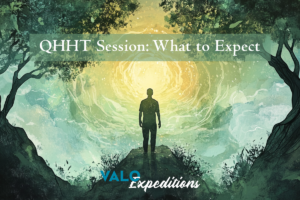A Journey Through Consciousness
Fear is a fundamental human emotion, deeply ingrained in our psyche, serving both as a protector and, at times, a barrier to growth. Technically, fear is a complex psychological and physiological response to perceived threats. It triggers a cascade of reactions in the body, releasing stress hormones like adrenaline and cortisol, preparing us for a fight-or-flight response. This ancient mechanism was crucial for our ancestors’ survival, allowing them to respond swiftly to immediate dangers. However, in our modern, comparatively safer world, fear often manifests in response to non-life-threatening situations, like public speaking or personal insecurities. It can also be the consequence of trauma. Our “unreasonable” fears stem from negative, many times unfounded beliefs, either about ourselves or others. Before I understood who I was and why we humans experience what we do, I was a person constantly dealing with fear. I experienced debilitating anxiety and often had to be medicated. Of course I still experience fear, I am a work in progress, but wish to share some of what helped me overcome many of my fears.
The Role of Consciousness in Understanding Fear
Consciousness plays a pivotal role in understanding and overcoming fear. It allows us to observe our fears without reacting, providing space to analyze and understand them. By exploring our consciousness, we delve into the layers of our mind, uncovering the roots of our fears. These roots are frequently tied to unresolved issues or unhealed traumas. To confront the fear we first have to sus out the root cause, the negative belief that is attached.
Recognizing, processing, and integrating fear can be a delicate and deeply personal journey. It involves becoming aware of the feelings, understanding the impact on your life, and taking steps to heal and integrate the experience.
- Set Your Intention: Say out loud or think, it is my intention to understand my fears, where they come from and why I am experiencing them in order to heal and integrate them. Intention is everything in this 3D existence.
- Acknowledge Your Feelings: Fear, anxiety, sadness, or anger can all be indicators of unresolved trauma. Fear can also indicate an erroneous or “negative” belief. In order to integrate and heal, you first have to understand what you are feeling.
- Identify the Reasons & Triggers: Now that you have identified what you are feeling, take a deep breath and focus on why you might be experiencing this feeling. You have to be willing to sit with the feeling and go deep inside- this can be uncomfortable. I often cry or experience fairly strong emotions while doing this work. That’s totally normal. Also, notice situations, people, or environments that trigger intense emotional reactions. These can help you understand why you feel what you do.
- Seek Information: Once you know what you’re feeling and why, educate yourself about trauma and its symptoms. Understanding common responses to trauma can help you recognize it in yourself.
- Mindfulness Practices: Engage in mindfulness practices like meditation, journaling, nature walks or deep breathing. These can help you stay grounded and present as you explore painful memories.
- Acceptance: Accepting what is causing your fears, that trauma occurred, or negative belief, without judgment, is crucial. This does not mean agreeing but rather acknowledging its impact on your life.
- Understanding Your Responses: Recognize how your reactions to trauma or your own negative beliefs have served as coping mechanisms. This understanding can foster compassion for yourself and your journey. Having compassion for oneself is key.
- Self-Care and Resilience Building: Engage in activities that strengthen your physical and emotional wellbeing. Exercise, healthy eating, sufficient sleep, and hobbies can improve your resilience. I workout 4-5 times a week, meditate daily and absolutely live to create and give away art, find something to be passionate about!
- Establish New Narratives: As you integrate your fears, you may begin to see yourself not as a victim, but as a survivor. Crafting a new narrative about your strength and resilience can be empowering.
Fear as a Guide to Inner Work
Our fears, when examined through the lens of our awareness, can guide us toward unresolved issues and unhealed traumas that need our attention. Rather than shying away from fear, embracing it as a signpost can lead to profound personal growth. For example, a fear of rejection may stem from early experiences of not feeling valued or loved. I experienced terrible rejection sensitivity (RSD) due to a poor bond with my mother as well as many traumatizing rejections from my peers as a young, impressionable child. I am not neurotypical, something I didn’t learn until fairly recently (in my 40’s). This neurological difference caused all sorts of interpersonal issues. I was that “weird” child, the one who was always “too much” for most people. My early experiences caused me to fear upsetting others, I became a people pleaser. Subsequent experiences cause this fear to compound- it became a living nightmare. Recognizing these internal connections offer us a pathway to healing these deep-seated wounds.
Overcoming Fear by Knowing Thyself
The adage “know thyself” holds profound wisdom in the context of overcoming fear. Understanding who we are, beyond our physical existence, involves deep inner work and exploration of our consciousness. This journey of self-discovery enables us to identify the triggers and origins of our fears. By acknowledging and accepting these aspects of ourselves, we can begin to heal and transform our fears into opportunities for growth.
Understanding and overcoming fear is a journey inward, through the landscapes of our consciousness. It requires courage, patience, and a willingness to confront what we often wish to avoid. By exploring our inner world, acknowledging our fears, and doing the necessary healing work, we can transform fear from a source of limitation to a catalyst for growth and self-discovery. Remember, the path to overcoming fear begins with a simple, profound step: seeking to know who we truly are at our core.
HELPFUL REMINDERS:
Mindfulness and Meditation: Regular practices of mindfulness and meditation can enhance our awareness, allowing us to observe our thoughts and fears without judgment. This observation is the first step toward understanding the nature of our fears.
Journaling: Writing down our fears and the situations in which they arise can help us identify patterns and triggers, facilitating a deeper understanding of their roots.
Therapy and Counseling: Professional guidance can be invaluable in exploring the depths of our consciousness and addressing unresolved fears or traumas.
Educational Exploration: Learning about the psychological and physiological aspects of fear can demystify the experience, making it less daunting.
Community and Support Groups: Sharing our fears within a supportive community can provide insights and encouragement, reminding us that we are not alone in our struggles. Check out NAMI for local support groups!




